what is the significance of the angle of repose in regard to mass wasting?
![By R.L. Schuster, U.Due south. Geological Survey [Public domain], <a href="https://commons.wikimedia.org/wiki/File%3AThistlelandslideusgs.jpg">via Wikimedia Commons</a> The 1983 Thistle landslide (foreground) dammed the Spanish Fork river creating a lake.](https://opengeology.org/textbook/wp-content/uploads/2016/07/Thistlelandslideusgs.jpg)
x Mass Wasting
KEY CONCEPTS
At the finish of this chapter, students should exist able to:
- Explain what mass wasting is and why it occurs on a gradient
- Explicate the basic triggers of mass-wasting events and how they occur
- Identify types of mass wasting
- Identify run a risk factors for mass-wasting events
- Evaluate landslides and their contributing factors
This chapter discusses the central processes driving mass-wasting, types of mass wasting, examples and lessons learned from famous mass-wasting events, how mass wasting can exist predicted, and how people can be protected from this potential take chances. Mass wasting is the downhill motion of stone and soil fabric due to gravity. The term
x.1 Slope Forcefulness
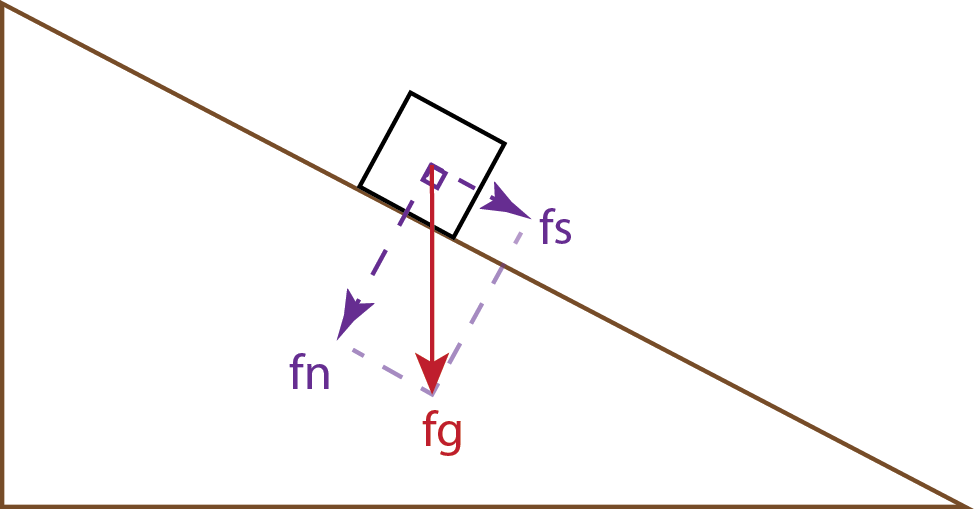
Mass wasting occurs when a slope fails. A slope fails when it is likewise steep and unstable for existing materials and weather. Slope stability is ultimately determined past two principal factors: the slope angle and the strength of the underlying fabric. Force of gravity, which plays a part in

In the figure, the strength vectors modify as the gradient angle increases. The gravitational force doesn't change, but the shear force increases while the normal force decreases. The steepest angle at which stone and
![By Captain Sprite at English Wikipedia (Transferred from en.wikipedia to Commons.) [CC BY-SA 2.5 (http://creativecommons.org/licenses/by-sa/2.5)], via Wikimedia Commons Angle of repose in a pile of sand.](https://opengeology.org/textbook/wp-content/uploads/2016/07/10.1_Angleofrepose.png)
Water is a common gene that can significantly modify the shear strength of a detail slope. Water is located in pore spaces, which are empty air spaces in sediments or rocks between the grains. For example, assume a dry sand pile has an
Another factor influencing shear strength are planes of weakness in sedimentary rocks.
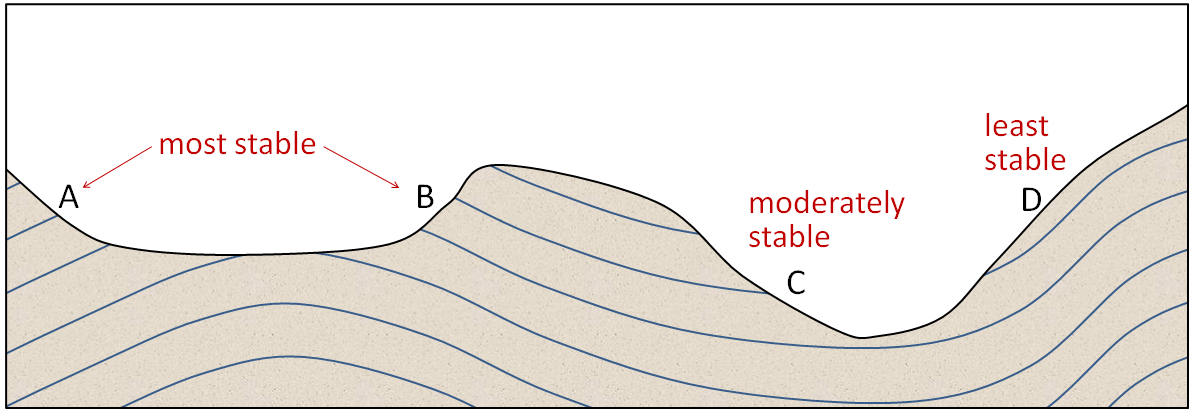
10.ii Mass-Wasting Triggers & Mitigation
Mass-wasting events often have a trigger : something changes that causes a landslide to occur at a specific time. It could exist rapid snowmelt, intense rainfall, earthquake shaking, volcanic eruption, storm waves, rapid-
An oversteepened slope may also trigger landslides. Slopes can be made excessively steep past natural processes of erosion or when humans modify the landscape for building construction. An case of how a gradient may be oversteepened during development occurs where the bottom of the slope is cutting into, peradventure to build a road or level a building lot, and the superlative of the slope is modified by depositing excavated fabric from below. If done carefully, this practice tin be very useful in land development, just in some cases, this can issue in devastating consequences. For example, this might have been a contributing cistron in the 2014 Northward Table salt Lake City, Utah landslide. A old gravel pit was regraded to provide a route and several edifice lots. These activities may take oversteepened the slope, which resulted in a wearisome moving landslide that destroyed one habitation at the bottom of the slope. Natural processes such as excessive stream erosion from a flood or littoral erosion during a storm tin besides oversteepen slopes. For instance, natural undercutting of the riverbank was proposed as role of the trigger for the famous 1925 Gros Ventre, Wyoming rock slide.
Slope reinforcement can assist forestall and mitigate landslides . For
A different approach in reducing landslide hazard is to
10.3 Landslide Classification & Identification
Mass-wasting events are classified by blazon of movement and type of material, and in that location are several ways to allocate these events. The effigy and table show terms used. In improver, mass-wasting types often share common morphological features observed on the surface, such as the head scarp—unremarkably seen as crescent shapes on a cliff face; hummocky or uneven surfaces; accumulations of talus—loose rocky material falling from to a higher place; and toe of slope, which covers existing surface material.
x.3.1 Types of Mass Wasting
The nearly common mass-wasting types are falls, rotational and translational slides, flows, and pitter-patter. Falls are precipitous rock movements that disassemble from steep slopes or cliffs. Rocks carve up along existing natural breaks such as
| Type of Movement | Primary Material Type and Mutual Name of Slide | |||
| Bedrock | Soil Types | |||
| Mostly Coarse-Grained | Mostly Fine-Grained | |||
| | Rock Fall | — | — | |
| Rock Avalanche | Rock Avalanche | — | — | |
| | — | Rotational Debris Slide (Slump) | Rotational Globe Slide (Slump) | |
| Translational Slide | Translational Rock Slide | Translational Debris Slide | Translational Earth Slide | |
| Flows | — | | World menstruation | |
| Soil Creep | — | Pitter-patter | | |
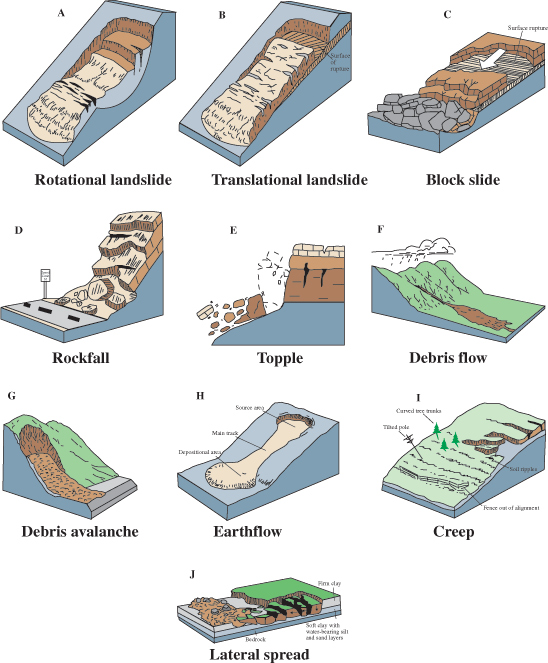
Flows are rapidly moving mass-wasting events in which the loose material is typically mixed with abundant h2o, creating long runouts at the gradient base. Flows are commonly separated into
Creep is the imperceptibly slow downward movement of cloth acquired by a regular cycle of nighttime freezing followed past daytime thawing in unconsolidated material such every bit soil. During the freeze, expansion of ice pushes soil particles out away from the gradient, while the next mean solar day following the thaw, gravity pulls them directly downward. The internet effect is a gradual motion of surface soil particles downhill.
x.3.2 Parts of a Landslide
Landslides have several identifying features that can be common across the different types of mass wasting. Note that there are many exceptions, and a
Many landslides have escarpments or scarps. Landslide scarps, like fault scarps, are steep terrain created when movement of the next land exposes a part of the subsurface. The virtually prominent scarp is the main scarp, which marks the uphill extent of the landslide. Equally the disturbed material moves out of identify, a pace slope forms and develops a new hillside escarpment for the undisturbed material. Chief scarps are formed by motion of the displaced material abroad from the undisturbed ground and are the visible function of slide rupture surface.
The slide rupture surface is the purlieus of the body of movement of the landslide. The geologic textile beneath the slide surface does not move, and is marked on the sides by the flanks of the
The toe of the landslide marks the terminate of the moving material. The toe marks the runout, or maximum distance traveled, of the landslide. In rotational landslides, the toe is frequently a large, disturbed mound of geologic material, forming as the
Rotational and translational
10.4 Examples of Landslides
Landslides in United States
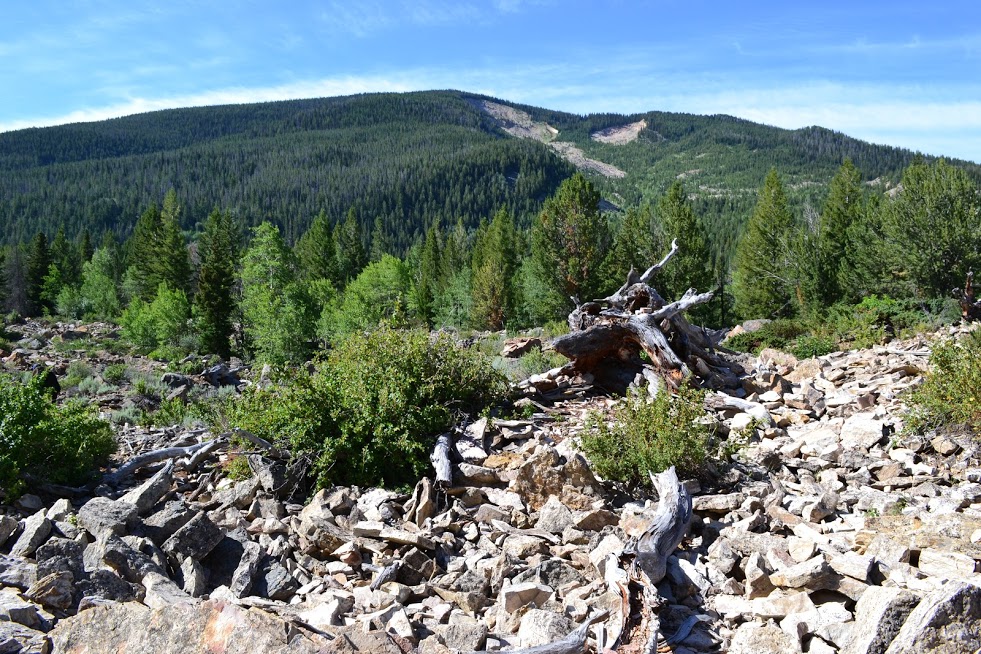
1925, Gros Ventre, Wyoming: On June 23, 1925, a 38 million cubic meter (50 million cu yd) translational rock slide occurred next to the Gros Ventre River (pronounced "grow vont") about Jackson Hole, Wyoming. Big boulders dammed the Gros Ventre River and ran upwardly the contrary side of the valley several hundred vertical feet. The dammed river created Slide Lake, and 2 years later on in 1927, lake levels rose loftier plenty to destabilize the dam. The dam failed and acquired a catastrophic flood that killed six people in the small-scale downstream community of Kelly, Wyoming.

A combination of three factors acquired the stone slide: 1) heavy rains and apace melting snowfall saturated the Tensleep Sandstone causing the underlying shale of the Amsden Formation to lose its
1959, Madison Canyon, Montana: In 1959, the largest earthquake in Rocky Mountain recorded history, magnitude 7.5, struck the Hebgen Lake, Montana area, causing a destructive seiche on the lake (see Chapter 9). The earthquake caused a stone avalanche that dammed the Madison River, creating Quake Lake, and ran up the other side of the valley hundreds of vertical feet. Today, there are still house-sized boulders visible on the slope opposite their starting indicate. The slide moved at a velocity of up to 160.9 kph (100 mph), creating an incredible air blast that swept through the Rock Creek Campground. The slide killed 28 people, most of whom were in the campground and remain cached there. In a way like the Gros Ventre slide, foliation planes of weakness in metamorphic rock outcrops were parallel with the surface, compromising shear strength.
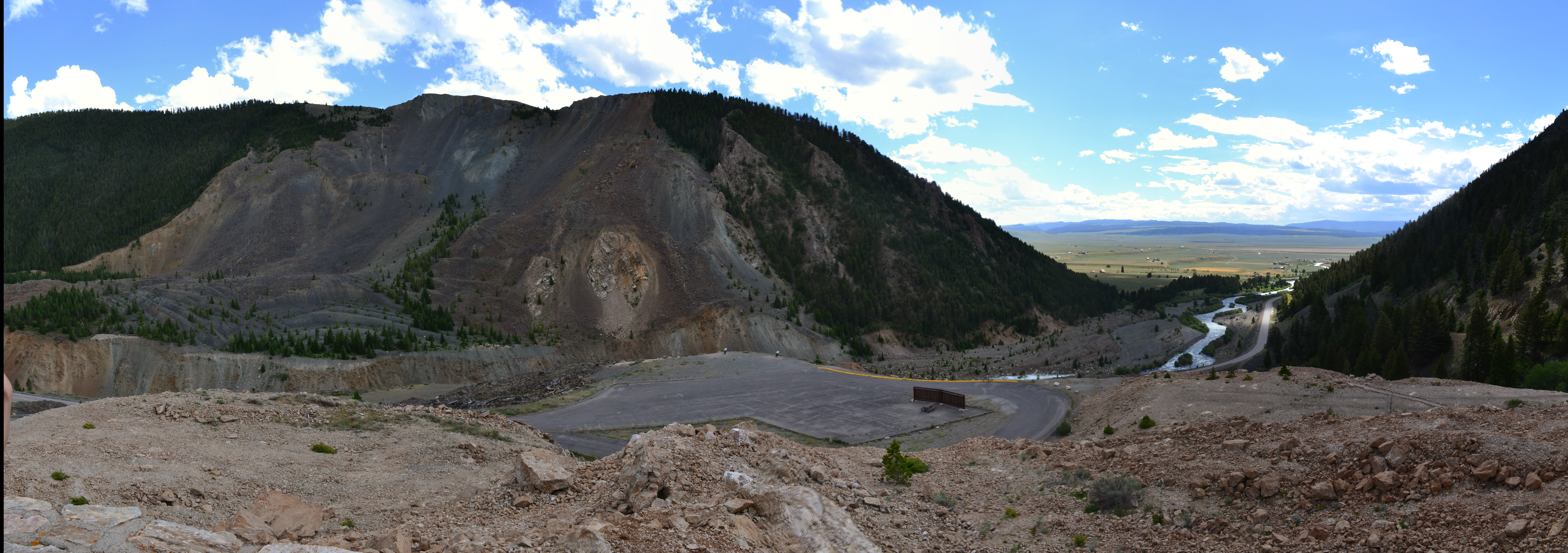
1980, Mount Saint Helens, Washington: On May 18, 1980 a five.1-magnitude earthquake triggered the largest
1995 and 2005, La Conchita, California: On March 4, 1995, a fast-moving earthflow damaged ix houses in the southern California coastal customs of La Conchita. A week later, a debris menstruum in the same location damaged 5 more than houses. Surface-tension cracks at the top of the slide gave early warning signs in the summer of 1994. During the rainy winter season of 1994/1995, the cracks grew larger. The probable trigger of the 1995 event was unusually heavy rainfall during the winter of 1994/1995 and ascension groundwater levels. Ten years after, in 2005, a rapid-debris flow occurred at the end of a xv-day menstruation of near-record rainfall in southern California. Vegetation remained relatively intact equally it was rafted on the surface of the rapid flow, indicating that much of the landslide mass simply was beingness carried on a presumably much more
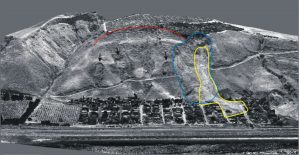
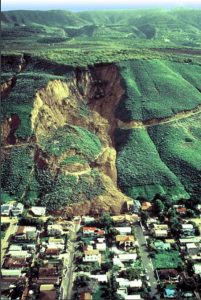
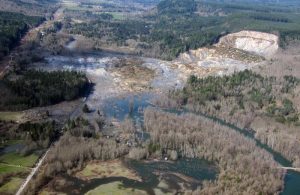
2014, Oso Landslide, Washington: On March 22, 2014, a
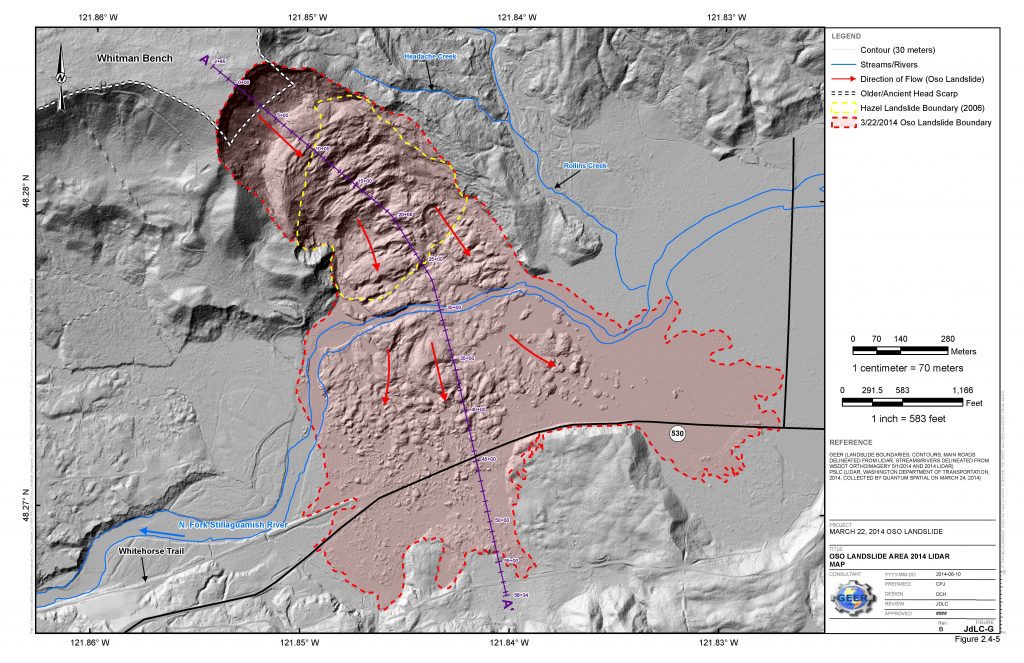
Yosemite National Park Stone Falls: The steep cliffs of Yosemite National Park cause frequent stone falls.
Utah Landslides
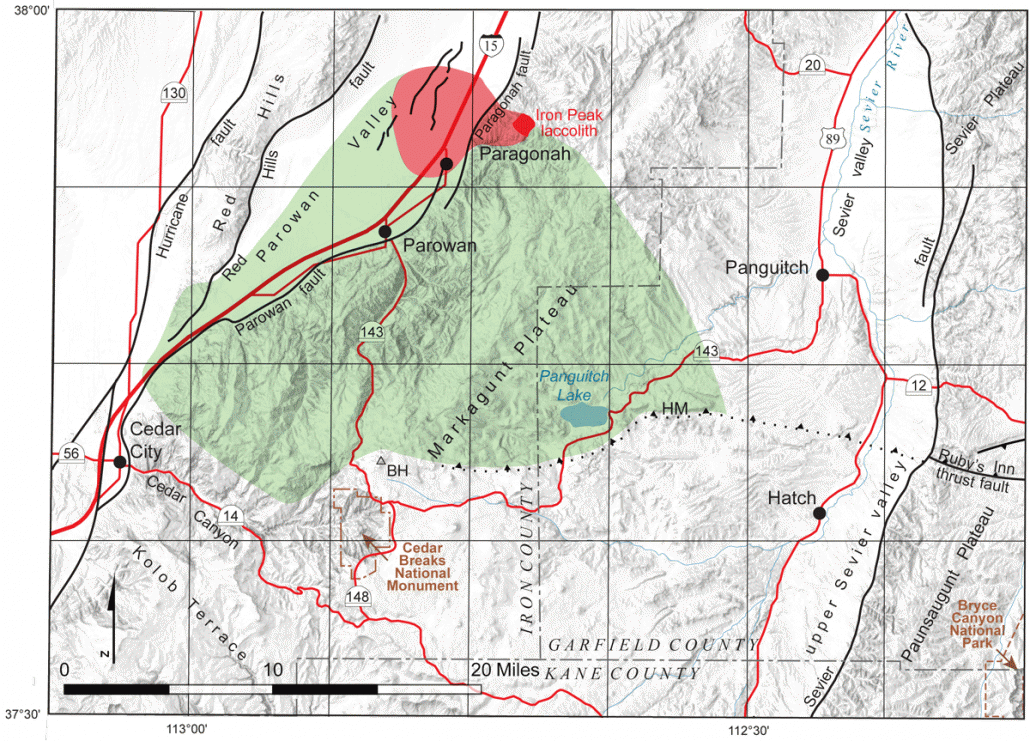
Markagunt Gravity Slide: Almost 21–22 one thousand thousand years agone, one of the biggest land-based landslides yet discovered in the geologic record displaced more than one,700 cu km (408 cu mi) of material in one relatively fast outcome. Evidence for this slide includes breccia conglomerates (see Affiliate five), glassy pseudotachylytes, (see Chapter vi), slip surfaces (similar to
![Past R.50. Schuster, U.S. Geological Survey [Public domain], <a href="https://commons.wikimedia.org/wiki/File%3AThistlelandslideusgs.jpg">via Wikimedia Commons</a> The 1983 Thistle landslide (foreground) dammed the Spanish Fork river creating a lake.](https://opengeology.org/textbook/wp-content/uploads/2016/07/Thistlelandslideusgs.jpg)
1983, Thistle Slide: Starting in April of 1983 and standing into May of that year, a slow-moving
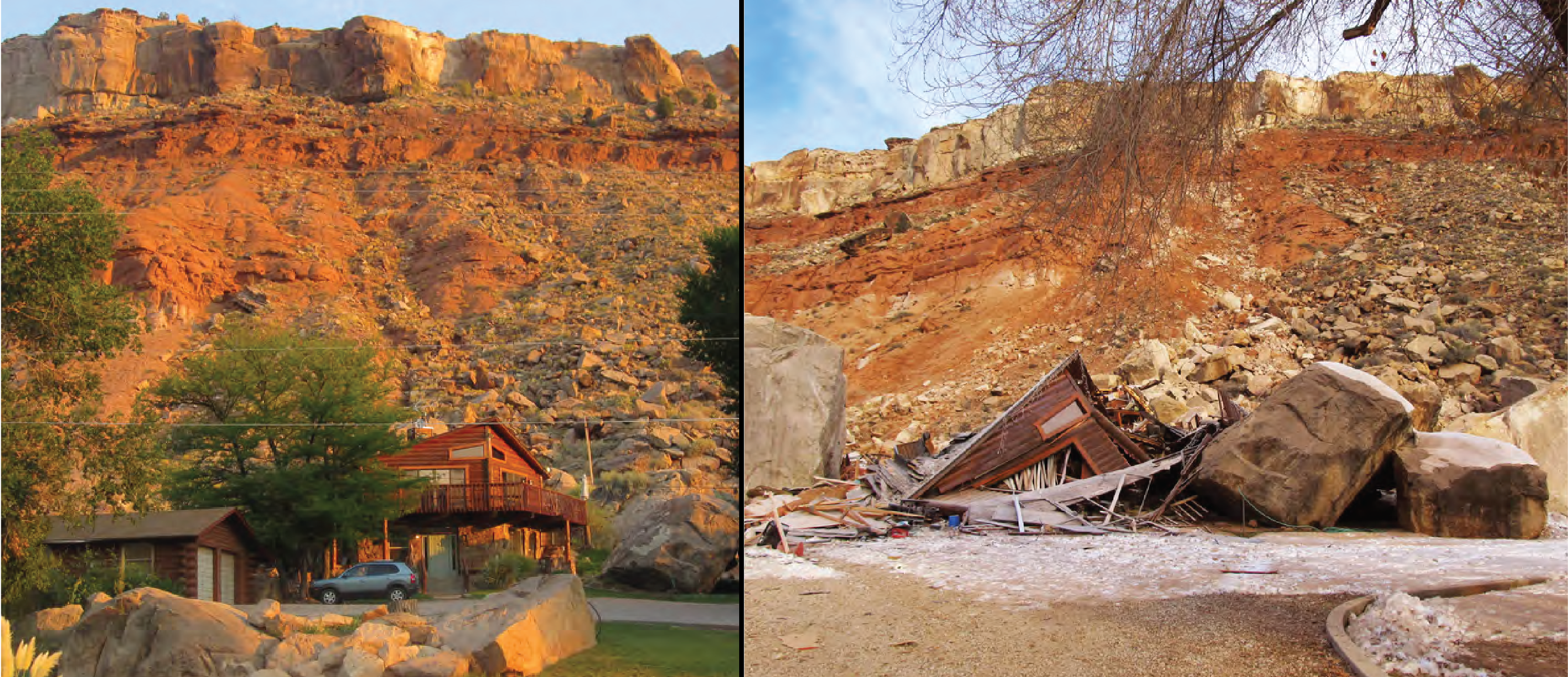
2013, Rockville Rock Autumn:Rockville, Utah is a modest customs near the entrance to Zion National Park. In December of 2013, a two,700 ton (1,400 ydiii) block of Shinarump Conglomerate fell from the Rockville Demote cliff, landed on the steep 35-degree slope beneath, and shattered into several large pieces that connected downslope at a high speed. These boulders completely destroyed a house located 375 feet below the cliff (see the before and after photographs) and killed two people inside the domicile. The topographic map shows other rock

2014, North Common salt Lake Slide: In August 2014 after a specially wet

Reports from residents suggested that ground cracks had been seen near the acme of the gradient at to the lowest degree a year prior to the catastrophic movement. The presence of easily-drained sands and gravels overlying more impermeable clays weathered from
Northward Salt Lake Landslide
2013, Bingham Canyon Copper Mine
10.five Chapter Summary
Mass wasting is a geologic term describing all downhill rock and soil movement due to gravity. Mass wasting occurs when a slope is too steep to remain stable with existing material and conditions. Loose rock and soil, chosen regolith, are what typically move during a mass-wasting event. Slope stability is adamant by two factors: the bending of the gradient and the shear strength of the accumulated materials. Mass-wasting events are triggered by changes that oversteepen gradient angles and weaken gradient stability, such equally rapid snow cook, intense rainfall, earthquake shaking, volcanic eruption, storm waves, stream erosion, and human activities. Excessive precipitation is the nearly common
Mass-wasting move ranges from slow to dangerously rapid. Areas with steep topography and rapid rainfall, such equally the California coast, Rocky Mountain Region, and Pacific Northwest, are specially susceptible to hazardous mass-wasting events. By examining examples and lessons learned from famous mass-wasting events, scientists take a better understanding of how mass-wasting occurs. This knowledge has brought them closer to predicting where and how these potentially chancy events may occur and how people tin exist protected.
References
- Haugerud, R.A., 2014, Preliminary estimation of pre-2014 landslide deposits in the vicinity of Oso, Washington: US Geological Survey.
- Highland, Fifty., 2004, Landslide types and processes: pubs.er.usgs.gov.
- Highland, L.Chiliad., and Bobrowsky, P., 2008, The
Landslide Handbook – A Guide to Agreement Landslides: U.Due south. Geological Survey USGS Numbered Series 1325, 147 p. - Highland, L.M., and Schuster, R.Fifty., 2000, Significant landslide events in the Us: U.s.a. Geological Survey.
- Hildenbrand, T.G., and Hendricks, J.D., 1995, Geophysical setting of the Reelfoot
rift and relations between rift structures and the New Madrid seismic zone: U.S. Geological Survey Professional Paper 1538-Eastward, 36 p. - Hungr, O., Leroueil, Southward., and Picarelli, L., 2013, The Varnes classification of landslide types, an update: Landslides, v. 11, no. 2, p. 167–194.
- Jibson, R.W., 2005,
Landslide hazards at La Conchita, California: United States Geological Survey Open up-File Report 2005-1067. - Lipman, P.West., and Mullineaux, D.R., 1981, The 1980 eruptions of Mount St. Helens, Washington: US Geological Survey USGS Numbered Series 1250, 844 p., doi: ten.3133/pp1250.
- Lund, W.R., Knudsen, T.R., and Bowman, S.D., 2014, Investigation of the December 12, 2013, Fatal Rock Fall at 368 W Chief Street, Rockville, Utah: Utah Geological Survey 273, 24 p.
- Usa Forest Service, 2016, A Brief History of the Gros Ventre Slide Geological Site: United States Forest Service.
Source: https://opengeology.org/textbook/10-mass-wasting/
0 Response to "what is the significance of the angle of repose in regard to mass wasting?"
Post a Comment